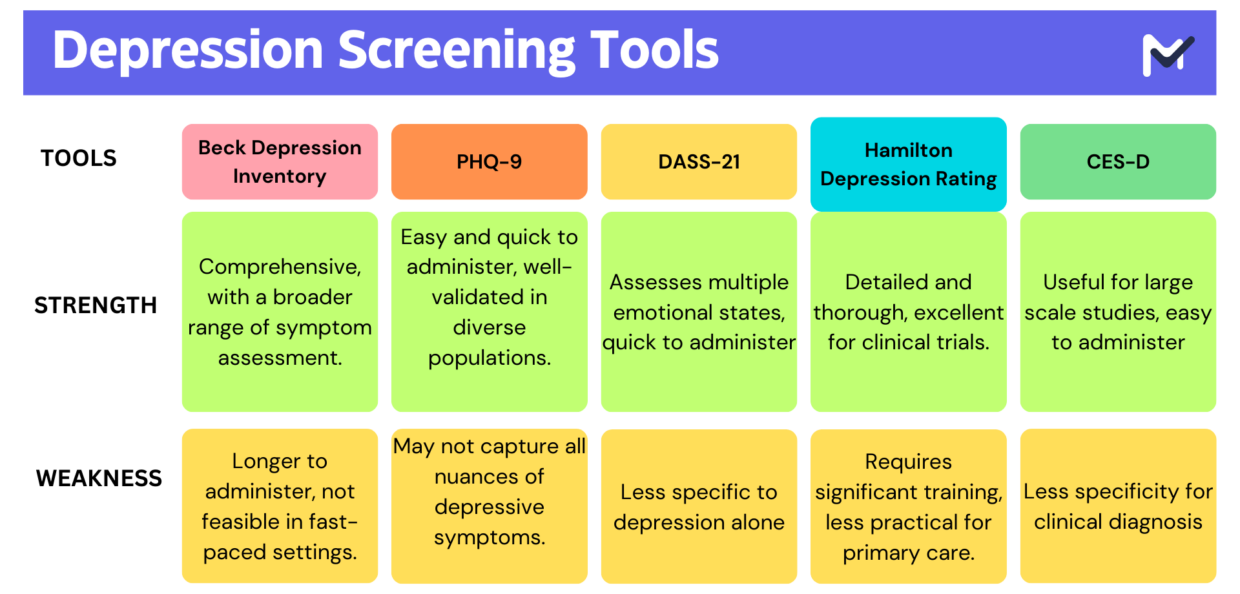Importance of Depression Screening Tools
Depression remains one of the most common yet challenging mental health disorders to diagnose accurately due to its varied symptoms and individual presentations. Effective depression screening tools are critical for clinicians not only to diagnose depression but also to assess its severity and plan appropriate interventions. Here is comparative analysis of several widely used depression screening tools, including the Patient Health Questionnaire-9 (PHQ-9), highlighting their strengths, weaknesses, validity, and reliability.
Overview of Common Depression Screening Tools
Patient Health Questionnaire-9 (PHQ-9)
The PHQ-9 is one of the most popular tools used worldwide due to its simplicity and effectiveness. It consists of nine questions based on the DSM-IV depression diagnostic criteria. Patients report the frequency of symptoms over the past two weeks, providing clinicians with a quick assessment of depression severity.
Beck Depression Inventory (BDI)
Another highly regarded tool, the Beck Depression Inventory, features 21 questions, each with four possible answers. The BDI is more detailed than the PHQ-9 and covers a wider range of symptoms, which can be beneficial in more thoroughly assessing depressive symptoms.
Hamilton Depression Rating Scale (HDRS)
The HDRS is often used in psychiatric settings and requires a trained clinician to administer. It includes up to 21 items and is considered the gold standard for assessing changes in depression severity over time, particularly in research settings.
DASS-21
The DASS-21, a quantitative measure of distress along the three axes of depression, anxiety, and stress. Unlike other tools that focus solely on depression, the DASS-21 allows clinicians to measure a broader spectrum of emotional states, which is crucial for comprehensive mental health assessment. This tool consists of 21 items, with seven items per scale, and asks individuals to use a 4-point severity/frequency scale to describe their experiences over the last week.
Center for Epidemiologic Studies Depression Scale (CES-D)
The CES-D is a 20-item questionnaire used primarily for screening the general population and in research studies to measure symptoms of depression and its severity. It is particularly noted for its use in epidemiological studies.
Comparative Analysis: Strengths and Weaknesses
PHQ-9
- Strengths: Easy and quick to administer, well-validated in diverse populations, effectively screens for depression and monitors treatment progress.
- Weaknesses: May not capture all nuances of depressive symptoms, such as atypical depression or symptoms more prevalent in specific populations.
Beck Depression Inventory
- Strengths: Comprehensive, with a broader range of symptom assessment, which can provide a more detailed depression profile.
- Weaknesses: Longer to administer, which might not be as feasible in fast-paced primary care settings.
Hamilton Depression Rating Scale
- Strengths: Detailed and thorough, excellent for tracking treatment changes over time, especially in clinical trials.
- Weaknesses: Requires significant training to administer effectively, less practical for primary care.
DASS-21
- Strengths: Provides a comprehensive overview of the patient’s emotional disposition by assessing three core emotional states, which can enhance the understanding of the interplay between anxiety, stress, and depression. It is quick to administer, scoring is straightforward, and it is well-suited for both clinical and non-clinical populations.
- Weaknesses: Since it covers multiple aspects of distress, its specificity to depression alone might be less compared to tools like the PHQ-9 or BDI, potentially requiring additional screening if specific diagnostic criteria for depression are needed.
Center for Epidemiologic Studies Depression Scale
- Strengths: Useful for larger scale or population-based studies, easy to administer.
- Weaknesses: Less specificity for clinical diagnosis, more focused on research applications.
Evaluating Validity and Reliability
Validity and reliability are crucial factors in choosing the right depression screening tool. The PHQ-9, for example, is highly valid across general and specific populations, making it a reliable choice for diverse clinical settings. On the other hand, while the HDRS offers high reliability in measuring treatment effects, its clinical utility is limited without specialized training. The DASS-21 is highly regarded for its psychometric properties, with strong internal consistency and validity across various populations. Its ability to distinguish between depression, anxiety, and stress also makes it particularly valuable in settings where these issues might overlap.
Choosing the Right Tool for Your Practice
When deciding which depression screening tool to implement, consider the specific needs of your practice and patient population. Depression screening tools are indispensable in diagnosing and managing depression effectively. By comparing tools like the PHQ-9, BDI, HDRS, CES-D, and now the DASS-21, clinicians can make informed decisions that enhance patient care and improve diagnostic accuracy. Whether in research, psychiatric, or primary care settings, selecting the appropriate tool is crucial for effective depression management strategies.
Conclusion
Depression screening tools are indispensable in the clinical diagnosis and management of depression. By understanding the strengths, weaknesses, validity, and reliability of these tools, clinicians can make informed decisions that enhance patient care and improve diagnostic accuracy. Whether in a research, psychiatric, or primary care setting, selecting the appropriate tool can significantly impact the effectiveness of depression management strategies.
This comprehensive overview aims to equip clinicians with the knowledge to select the best depression screening tool for their practice needs, ultimately leading to better patient outcomes and more effective treatment plans.


